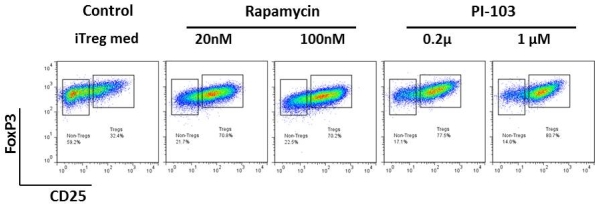Dual PI3K-mTOR Inhibition on Human T Cell Activation, Proliferation, and Differentiation: The First Step in the Development of New Immunosuppressants
1Department of Surgery - Transplant Section, University of Kentucky, Lexington, KY
2Department of Microbiology, Immunology and Molecular Genetics, University of Kentucky, Lexington, KY
3Free Radical Biology in Cancer Shared Resource Facility, University of Kentucky, Lexington, KY.
Meeting: 2015 American Transplant Congress
Abstract number: A246
Keywords: Immunosuppression, Negative selection, T cell activation
Session Information
Session Name: Poster Session A: Preclinical Immunosuppression and Tolerance
Session Type: Poster Session
Date: Saturday, May 2, 2015
Session Time: 5:30pm-7:30pm
 Presentation Time: 5:30pm-7:30pm
Presentation Time: 5:30pm-7:30pm
Location: Exhibit Hall E
Background: Regulatory T lymphocytes (Tregs) contribute to transplant tolerance. We have demonstrated that the inhibition of PI3K-mTOR pathway has a major role in the differentiation of naive T cells into functional suppressor Tregs. Objective: To evaluate the effect of the dual PI3K-mTOR inhibitor, PI-103, in human naive CD4+ T cells. Methods: Negatively selected human naive CD4+ T cells were activated with OKT3+anti CD28 and/or OKT3+IL-2 in the presence or absence of different doses of PI-103 and Rapamycin. Multi-parametric FACS analyses were used to measure the expression of early activation markers, lymphokine synthesis, T cell proliferation and differentiation into Tregs or Th17 effector cells. Results: PI-103 induced a significant delay on the expression of early activation markers CD69 and CD25, reduced IL-2 production and decreased proliferation rate in CD4+ T cells. PI-103 increased iTreg conversion from primary human naïve CD4+ T cells and prevented pro-inflammatory Th17 polarization. Analysis of proliferative Ki67+ T cells revealed the preferential targeting of PI-103 to the non-Treg population. Western blot results illustrated the distinct targets of PI-103 suggesting the modulation of feedback loops as a mechanism of the PI-103 dose-dependent increment of mTORC2 activity. PI-103 reduced the glycolytic rate of the cells although showed a delayed metabolic shift. Conclusions: PI-103 shares similar tolerogenic properties with Rapamycin, although distinct molecular mechanism and kinetic responses. Our findings suggest that the dual inhibitory capacity of PI-103 results in the accumulation of iTreg cells and suppression of effector T cells. These results warrant further studies to assess the role of dual PI3K-mTOR inhibition on immunosuppression.
Western blot results illustrated the distinct targets of PI-103 suggesting the modulation of feedback loops as a mechanism of the PI-103 dose-dependent increment of mTORC2 activity. PI-103 reduced the glycolytic rate of the cells although showed a delayed metabolic shift. Conclusions: PI-103 shares similar tolerogenic properties with Rapamycin, although distinct molecular mechanism and kinetic responses. Our findings suggest that the dual inhibitory capacity of PI-103 results in the accumulation of iTreg cells and suppression of effector T cells. These results warrant further studies to assess the role of dual PI3K-mTOR inhibition on immunosuppression.
To cite this abstract in AMA style:
Vilchez V, Castellanos A, Butterfield D, Mitov M, Hoopes C, Marti F, Gedaly R. Dual PI3K-mTOR Inhibition on Human T Cell Activation, Proliferation, and Differentiation: The First Step in the Development of New Immunosuppressants [abstract]. Am J Transplant. 2015; 15 (suppl 3). https://atcmeetingabstracts.com/abstract/dual-pi3k-mtor-inhibition-on-human-t-cell-activation-proliferation-and-differentiation-the-first-step-in-the-development-of-new-immunosuppressants/. Accessed December 15, 2025.« Back to 2015 American Transplant Congress
